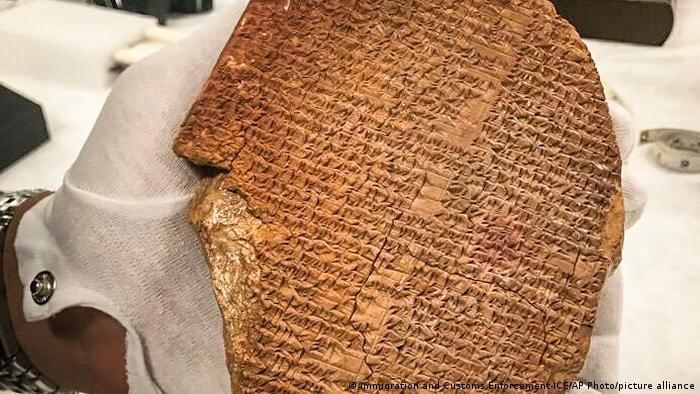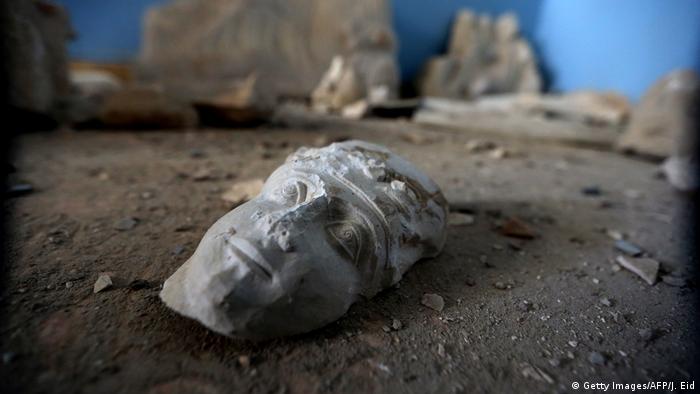A stone inscription bearing part of the Epic of Gilgamesh and thousands of other priceless, ancient objects were stolen following the 2003 US invasion of Iraq.

Gilgamesh's 'dream tablet' FOUND AT THE USA HOBBY LOBBY BIBLE MUSEUM
Iraqi historian Abdullah Khorsheed Qader has been working in the field of archaeology since 2000, when he started his master's degree at the Salah-al-Din University in Erbil, northern Iraq, and where he went on to become a professor at the university's department of archaeology.
As a scholar and the director of the Iraqi Institute for the Conservation of Antiquities and Heritage, Qader is elated his country will get back its ancient treasures from the US. "Feeling great and hopeful because of the positive responses from the United States of America," he told DW in an email interview.
17,000 artifacts to be returned
On Wednesday, the US announced it was returning 17,000 archaeological artifacts to Iraq. The objects, which are around 4,000 years old and from the Sumerian period, were returned on Thursday onboard the flight of Iraqi Prime Minister Mustafa al-Kadhimi, who was in Washington DC for a meeting with US President Joe Biden.
Calling the restitution "unprecedented," Iraqi culture minister Hassan Nazim said it was "the largest return of antiquities to Iraq" and a "result of months of efforts by the Iraqi authorities in conjunction with their embassy in Washington," he said in a press statement. In 2018, the British government returned ancient objects that were similarly looted after the US invasion and which then appeared in England.
Watch video 42:31 Stolen - Blood antiquities
Stolen during the US invasion
"Most of these artifacts were part of the materials that were that were looted from the Iraq Museum in Baghdad during the US invasion," Elizabeth Stone, an archaeologist and professor of anthropology at the Stony Brook University in New York, told DW. Stone has been a part of various archaeological expeditions to Iraq, including a notable one in 2012, where she and her team excavated close to the site of Ur, the home of the biblical figure of Abraham.
According to Stone, these objects left Iraq through illegal trade in antiquities. "It was clear to everyone that these had been stolen from the Museum since they had catalog numbers on them and so could not have come from illegal excavations," the archaeologist added.
Some objects were confiscated by customs officials, but others were bought by Cornell University and Hobby Lobby, the arts and crafts chain, Stone said.
Hobby Lobby was in the news recently after it was revealed the business had acquired a rare tablet in cuneiform script, inscribed with a portion of the Epic of Gilgamesh. The object was bought to display at the Museum of the Bible in Washington DC — the institution is funded by the family of David Green, Hobby Lobby's founder.
On July 27, a New York court ordered the forfeiture of the object, which was reportedly purchased by an American antiquities dealer from the family of a London coin dealer, the US Department of Justice said in a statement.
"The antiquities dealer and a US cuneiform expert shipped the tablet into the United States by international post without declaring the contents as required. After the tablet was imported and cleaned, experts in cuneiform recognized it as bearing a portion of the Gilgamesh Epic. The tablet measures approximately 6 inches by 5 inches [15 x 12 centimeters] and is written in the Akkadian language," according to the press statement.
The Epic of Gilgamesh
The Sumerian poem is considered one of the oldest works of literature, and together with several thousand other objects, comprises one of the largest caches of archaeologically important artifacts that were stolen from Iraq following the 2003 US-led invasion.
Illegal excavation, theft and smuggling of historical artifacts is an ongoing problem — especially in Iraq and Syria — with black market dealers, smugglers and members of the "Islamic State" (IS) exploiting the chaotic situation in the region, where it is relatively easy to find antiquities and sell them abroad.
WHAT'S LEFT OF THE ANCIENT CITY OF PALMYRA?IS strikes againWhat is now left of the ancient ruins at Palmyra - known as the "Pearl of the Desert" - is uncertain after a new strike by IS militants on Thursday. This photo shows the face of statue at a destroyed museum in March 2016. Syrian government forces had recaptured Palmyra that month from jihadists, who view the UNESCO-listed site's ancient ruins as idolatrous. 12345
Iraqi officials prepare
Meanwhile, archaeologists like Qader are happy that efforts to bring back the treasures have borne fruit. "Iraqi contacts with the American side made it clear that the smuggled antiquities are in the safe hands of the American Homeland Security," Qader says. Embassy officials had been communicating for many years to recover these pieces and "this has become a reality, finally," adds Qader.
He hopes that the rest of the world, too, will step in and help recover other lost artifacts. Meanwhile, the archaeologist and his colleagues are busy laying the groundwork for re-establishing archaeological institutions that were damaged during years of war and conflict.
Together with US organizations like the Smithsonian Institution and the University of Delaware, Qader, the director of the Iraqi Institute for the Conservation of Antiquities and Heritage, is training young professionals and educating the community.
One important goal of his program is "restoring confidence and self-belief in the Iraqi Museum community and archaeological professionals by building and strengthening a national conservation program for cultural heritage."
Meanwhile, archaeologists like Qader are happy that efforts to bring back the treasures have borne fruit. "Iraqi contacts with the American side made it clear that the smuggled antiquities are in the safe hands of the American Homeland Security," Qader says. Embassy officials had been communicating for many years to recover these pieces and "this has become a reality, finally," adds Qader.
He hopes that the rest of the world, too, will step in and help recover other lost artifacts. Meanwhile, the archaeologist and his colleagues are busy laying the groundwork for re-establishing archaeological institutions that were damaged during years of war and conflict.
Together with US organizations like the Smithsonian Institution and the University of Delaware, Qader, the director of the Iraqi Institute for the Conservation of Antiquities and Heritage, is training young professionals and educating the community.
One important goal of his program is "restoring confidence and self-belief in the Iraqi Museum community and archaeological professionals by building and strengthening a national conservation program for cultural heritage."

No comments:
Post a Comment